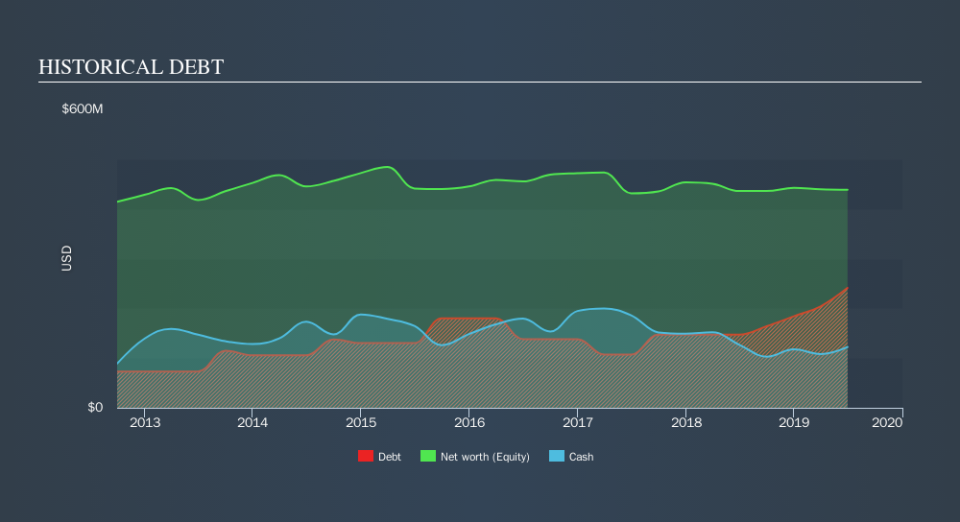Does Himax Technologies (NASDAQ:HIMX) Have A Healthy Balance Sheet?

Some say volatility, rather than debt, is the best way to think about risk as an investor, but Warren Buffett famously said that 'Volatility is far from synonymous with risk. So it seems the smart money knows that debt - which is usually involved in bankruptcies - is a very important factor, when you assess how risky a company is. We can see that Himax Technologies, Inc. (NASDAQ:HIMX) does use debt in its business. But the real question is whether this debt is making the company risky.
When Is Debt A Problem?
Generally speaking, debt only becomes a real problem when a company can't easily pay it off, either by raising capital or with its own cash flow. Part and parcel of capitalism is the process of 'creative destruction' where failed businesses are mercilessly liquidated by their bankers. However, a more common (but still painful) scenario is that it has to raise new equity capital at a low price, thus permanently diluting shareholders. Of course, debt can be an important tool in businesses, particularly capital heavy businesses. The first thing to do when considering how much debt a business uses is to look at its cash and debt together.
View our latest analysis for Himax Technologies
What Is Himax Technologies's Debt?
As you can see below, at the end of June 2019, Himax Technologies had US$241.0m of debt, up from US$147.0m a year ago. Click the image for more detail. However, it does have US$122.4m in cash offsetting this, leading to net debt of about US$118.7m.
How Healthy Is Himax Technologies's Balance Sheet?
Zooming in on the latest balance sheet data, we can see that Himax Technologies had liabilities of US$417.4m due within 12 months and liabilities of US$5.93m due beyond that. Offsetting these obligations, it had cash of US$122.4m as well as receivables valued at US$177.5m due within 12 months. So its liabilities total US$123.5m more than the combination of its cash and short-term receivables.
While this might seem like a lot, it is not so bad since Himax Technologies has a market capitalization of US$389.0m, and so it could probably strengthen its balance sheet by raising capital if it needed to. But it's clear that we should definitely closely examine whether it can manage its debt without dilution. There's no doubt that we learn most about debt from the balance sheet. But it is future earnings, more than anything, that will determine Himax Technologies's ability to maintain a healthy balance sheet going forward. So if you want to see what the professionals think, you might find this free report on analyst profit forecasts to be interesting.
In the last year Himax Technologies's revenue was pretty flat, and it made a negative EBIT. While that's not too bad, we'd prefer see growth.
Caveat Emptor
Importantly, Himax Technologies had negative earnings before interest and tax (EBIT), over the last year. To be specific the EBIT loss came in at US$2.5m. When we look at that and recall the liabilities on its balance sheet, relative to cash, it seems unwise to us for the company to have any debt. Quite frankly we think the balance sheet is far from match-fit, although it could be improved with time. Another cause for caution is that is bled US$61m in negative free cash flow over the last twelve months. So suffice it to say we consider the stock very risky. For riskier companies like Himax Technologies I always like to keep an eye on the long term profit and revenue trends. Fortunately, you can click to see our interactive graph of its profit, revenue, and operating cashflow.
When all is said and done, sometimes its easier to focus on companies that don't even need debt. Readers can access a list of growth stocks with zero net debt 100% free, right now.
We aim to bring you long-term focused research analysis driven by fundamental data. Note that our analysis may not factor in the latest price-sensitive company announcements or qualitative material.
If you spot an error that warrants correction, please contact the editor at editorial-team@simplywallst.com. This article by Simply Wall St is general in nature. It does not constitute a recommendation to buy or sell any stock, and does not take account of your objectives, or your financial situation. Simply Wall St has no position in the stocks mentioned. Thank you for reading.

 Yahoo Finance
Yahoo Finance 
